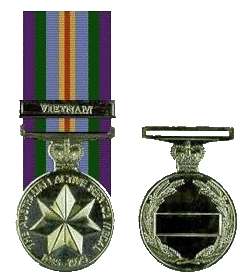
The Australian Active Service Medal 1945-75
Notice given to local members on 24 September 1997. Letters Patent: C.A.G. S18 dated 19 January 1998.
The Australian Active Service Medal 1945 - 1975, with Clasps denoting areas of service, is awarded to members of the Australian Defence Force and certain Australian civilians for service in specified areas overseas. There are four approved Clasps for this medal, Korea, Malaya, Malaysia and Vietnam, each with respective qualifying areas and periods.
Name of Award: The Australian Active Service Medal 1945 - 1975 with Clasp, Vietnam
Description of Ribbon: A narrow central red stripe flanked by two narrow yellow stripes, which are in turn flanked by two light blue bands. On the outer edges are stripes of purple with dark green stripes on their inner edges.
Clasp or Emblem Worn (if Awarded)
Clasp, Vietnam
Conditions of Award
Awarded to members of the Australian Defence Force, civilian members of the Department of Defence, civilian contractors of the Department of Defence, members of the Australian Merchant Navy; members of an Australian Surgical and Medical Team; Australian War Correspondents; members of the Salvation Army, Australian Red Cross, Australian Young Men's Christian Association and Australian Campaigners for Christ, who qualified for the General Service Medal 1962 with Clasp South Vietnam, the Vietnam Medal or the Vietnam Logistic and Support Medal for service in South Vietnam between 24 December 1962 and 27 January 1973.
Eligibility for the Australian Active Service Medal 1945-75 has recently been extended to:
RAN personnel who served with the Far East Strategic Reserve (FESR) during the Malayan Emergency. These personnel will also be eligible for the Naval General Service Medal; Official, uniformed war correspondents and war artists who served with ADF personnel during the Malayan Emergency; ADF personnel awarded the General Service Medal 1962 with Clasp 'Brunei' for service during the Indonesian Confrontation; RAN personnel serving in HMAS Vampire during the Indonesian Confrontation; ADF members serving on the Thai Malay border immediately after the Malayan Emergency, between 1 August 1960 and 27 May 1963; ADF members seconded to the Royal Malaysian Armed Forces during the Indonesian Confrontation; Australian Army Air Dispatch serving with 55 AD Coy RASC or 'Miscellaneous Australian Detachments unit of FARELF'; Personnel who served at RAAF Base Ubon in Thailand between 26 June 1965 and 31 August 1968; and QANTAS crew members who served on RAAF charter flights during the Vietnam War from 1964-73.
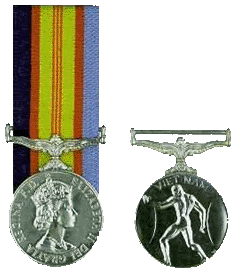
The Vietnam Medal
Vietnam Medal - British Imperial Award
Name of Award: Vietnam Medal
Description of Ribbon: Three narrow red stripes on a broad central yellow band boarded by red. A broad dark blue strip on the left, and a broad light blue stripe on the right.
Clasp or Emblem Worn (if Awarded)
Mention In Despatches
Conditions of Award
One day or more on the posted strength of a Unit or formation in Vietnam. A total of 28 days in ships or craft in inland waters or off the coast. 30 days service on the basis of official visits, inspections or other occurrences of a temporary nature of duty.
Period: 29 May 1964 to 27 January 1973
Persons eligible for the Vietnam Medal are not eligible for the Vietnam Logistic and Support Medal
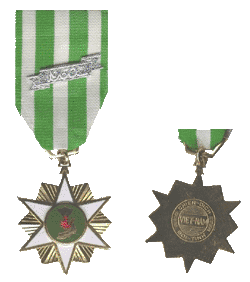
The Vietnamese Campaign Medal
Vietnamese Campaign Medal - South Vietnamese Government Award
This was the hardest Vietnam era medal to earn as it required at least 181 days "special service" in Vietnam, unless terminated by battle casualty. As a Foreign Award it is ranked junior to all Australian Awards.
Name of Award: Vietnamese Campaign Medal
Description of Ribbon: Green with three vertical white stripes. Date cluster "1960-" worn centrally on ribbon with straight sides of scroll perpendicular.
Clasp or Emblem Worn (if Awarded)
Nil
Conditions of Award Awarded by the Government of the Republic of Vietnam. "Special Service" totalling at least 181 days in South Vietnam, unless terminated by a Battle Casualty.
Period: 31 July 1962 to 28 March 1973.
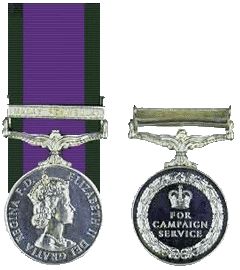
General Service Medal (1962)
General Service Medal (1962) - British Imperial Award
Assented to in 1961. There are three approved Clasps for this medal, South Vietnam, Borneo and Malay Peninsula, each with respective qualifying areas and periods.
Name of Award: General Service Medal 1962 with Clasp, South Vietnam
Description of Ribbon: Purple with green edges
Clasp or Emblem Worn (if Awarded)
Mention In Despatches
Conditions of Award
30 days service in South Vietnam between 24 December 1962 and 28 May 1964. Awarded only to members of Australian Army Training Team, Vietnam.
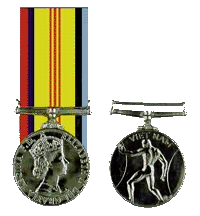
Vietnam Logistic and Support Medal
Vietnam Logistic and Support Medal
Name of Award: Vietnam Logistic and Support Medal
Description of Ribbon
Three narrow red stripes on a broad central yellow band. Bordered on the left by a red stripe with an inner dark blue stripe. Bordered on the right by a light blue stripe with an inner stripe of dark brown.
Clasp or Emblem Worn (if Awarded)
Nil
Conditions of Award
Awarded to members of the Australian Armed Forces who rendered service in support of the Australian Armed Forces in operations in Vietnam between 29 May 1964 and 27 January 1973. May also be awarded to Accredited Civilian War Correspondents, Australian Entertainers, Civilian Surgical Aid Teams, Civilian Defence Contractors, QANTAS Flight Crew and members of the Merchant Navy, who rendered service in support of the Australian Armed Forces in Vietnam. Actual service within Vietnam is required.
Persons eligible for the Vietnam Medal are not eligible for the Vietnam Logistic and Support Medal.

Australian Defence Medal
Name of the Award: The Australian Defence Medal.
Description of Ribbon: The ADM ribbon is red with black edges, the colours of the Flanders poppy that represent the Anzac spirit of the Australian armed forces. The white stripes divide the ribbon into three, to denote the three Services and also represent service contributing to the peace of Australia .
Clasp or Emblem Worn (if Awarded)
Nil
Condition of Award: The ADM recognises Australian Defence Force personnel who have efficiently completed either: an initial enlistment period, or four years service,
whichever is the lesser, and all of the relevant service was after 3 September 1945.
Included are former Defence Force members who did not complete the qualifying period because they: died in service,
were medically discharged (based upon individual circumstances), or
left the service due to a Defence workplace policy of the time. (For example, in the past a woman was required to resign on marriage.)

Australian Army Infantry Combat Badge
Australian Army Infantry Combat Badge
Agreed to in early 1971
Name of Award: Australian Army Infantry Combat Badge
Description of Badge:
The badge, finished in bronze, is in the form of a (vertically mounted Australian Army SLR) bayonet surrounded by (an oval shaped) laurel wreath. It is approximately 28 mm wide and fixed to the uniform by means of pins and clutch grips.
Clasp or Emblem Worn (if Awarded)
Nil
Conditions of Award
Except as provided in the following, the Infantry Combat Badge may only be awarded to a serving member of the Australian Army who has given, either continuous or aggregate, 90 days satisfactory service as an infantryman in operations.
Service as an infantryman means service as a member of the Royal Australian Infantry Corps in an infantry posting in an Australian Infantry Battalion, Independent Rifle Company, Commando Company, Special Air Service Regiment, or other such Australian unit as may be designated by the Chief of General Staff.
Operations is defined as service in a war or campaign in respect of which a campaign star or medal is awarded.
Special circumstances exist where members of other Corps may be awarded the badge. These are dealt with on a case by case basis by an Infantry Combat Badge Committee. These "special circumstances" are not dealt with here in these notes.
Wearing of the Badge
The Infantry Combat Badge is worn on the left breast, centrally placed one (1) cm immediately above the medal ribbons or medals. The Badge is worn with the bayonet pointing upwards and is not to be polished.
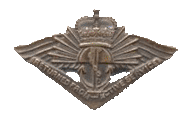
Returned from Active Service Badge
Returned from Active Service Badge
The Returned from Active Service Badge in its present form, has been awarded to eligible service personnel since 1939. The only significant change occurred when the current Queen's crown replaced that of her fathers'. It continues to be awarded today in conjunction with the Australian Active Service Medal where service qualifies for the award of this medal, eg Kuwait and Somalia and is being issued for current service in areas such as East Timor, today.
Returned from Active Service Badges have a unique serial number on their reverse side. This is a manufacturing number, and is not related to Service Numbers. For World War Two soldiers, these serial numbers were recorded in the Individuals Service Records and were also recorded on the Individual's Certificate of Discharge.
The badges are awarded by the Australian Army, Royal Australian Air Force, Royal Australian Navy and the Australian Mercantile Marine, and have a letter prefixed to the serial number to identify the branch of the service by which it was issued:
A = Army; AF = Air Force; N = Navy; MN = Merchant Navy.
The words "Issued by the C'wlth Govt" are moulded on the back of the badge along the boomerang on Vietnam era badges.
Name of Award: Returned from Active Service Badge
Description of Badge:
This badge combines the emblems of all services together in the following manner. A centrally placed Crown mounted above a chain and anchor which in turn rests in the middle of an up turned boomerang. A raising sun badge sits behind the crown which in turn is placed in front of a pair of RAAF wings. The words, "Returned from Active Service Badge" are inscribed into the front of the boomerang.
Clasp or Emblem Worn (if Awarded)
Nil
Conditions of Award, (Australian Army)
Service in Vietnam (Southern Zone) between 31 July 1962 and 27 January 1973.
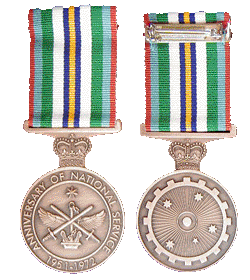
The Anniversary of National Service
1951-1972 Medal
The Anniversary of National Service 1951-1972 Medal
Name of Award: Anniversary of National Service 1951 - 1972 Medal
Description of Ribbon:
Clasp or Emblem Worn (if Awarded)
Nil
Conditions of Award
To be issued to all "National Service" personnel called up for national service under various conscription schemes during the period January 1951 to December 1972. Eligibility for the medal will be dependent upon individuals having completed their national service obligation under either schemes put in place during the above period.
General Comments
It is a new commemorative medal only, not a service medal!
It has been stuck to mark the 50th anniversary of the introduction of universal conscription in 1951. Its issue is controversial and is considered by some as a political whim to keep a small vocal pressure group "happy".

Vietnam War commemorative medallion and certificate
Vietnam War commemorative medallion and certificate
27 March 2023 - DVA Announcement
To acknowledge the 50th anniversary of the end of Australia’s involvement in the Vietnam War, the Department of Veterans’ Affairs will produce a Commemorative Medallion and Certificate of Commemoration.
The medallion and certificate will be made available to every living veteran, widows of veterans and other family members of veterans of the Vietnam War. Please note that only one medallion is available per Vietnam War veteran. While Australia can never repay the debt we owe to the 60,000 who served in Vietnam, this medallion and certificate are a small but meaningful way to honour their service and to recognise the sacrifice of those who never returned home.
The obverse design will feature the Commonwealth Coat of Arms with ‘Vietnam War’ inscribed at the top and “Australia remembers’ at the bottom. The medallion reverse design will feature words of thanks at the bottom with the years 1962-73 inscribed at the top to represent the years in which Australia was involved in the Vietnam War. The medallion also features a UH-1 Iroquois “Huey” Helicopter, a depiction of HMAS Sydney (III) “Vung Tau Ferry” and an Australian solider holding an SLR.
The medallion will be presented in a display case and will include a card that explains the design and contains a brief expression of thanks.
The design of the commemorative certificate will complement the medallion. The design includes the Commonwealth Coat of Arms, ‘Australia Remembers’ wording and includes the signature of both the Governor-General and the Prime Minister.
The certificate will be contained within its own folder that will allow for independent display, framing and mounting.
Applications can be made online at National Mail & Marketing through the DVA website.
If you are having difficulties with your application and require assistance please phone 1800 VETERAN (1800 838 372) between 9am and 5pm AEST Monday to Friday and when prompted say the word ‘medallions’.
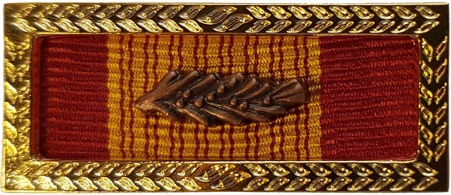
Republic of Vietnam Cross of Gallantry with Palm Unit Citation
Republic of Vietnam Cross of Gallantry with Palm Unit Citation
Australian Defence Force members who served during the Vietnam War have been recognised with the Republic of Vietnam Cross of Gallantry with Palm Unit Citation (the Citation).
The Citation was awarded by the former Government of the Republic of Vietnam (South Vietnam) to military units that distinguished themselves in battle. The Governor-General has formally approved the awarding of the Citation to Australian military units in recognition of their service during the Vietnam War.
Eligibility
To be eligible for the Citation, Navy and Air Force members must have served in Vietnam as part of a unit awarded by the former Government of the Republic of Vietnam or a unit under the operational control of United States Military Assistance Command Vietnam, during the eligible dates.
Navy
- Clearance Diving Team Three from 5 February 1967 to 5 May 1971
- RAN Helicopter Flight Vietnam from 16 October 1967 to 8 June 1971
- RAN personnel in 9 Squadron from February 1968 to April 1969 (8 personnel).
Air Force
- RAAF Transport Flight Vietnam/35 Squadron from August 1964 to February 1972
- 9 Squadron from June 1966 to December 1971
- 2 Squadron from 19 April 1967 to 15 July 1971
- Base Support Flight Vietnam from 8 February 1962 to 28 March 1973
- Number 1 Operational Support Unit from 8 February 1962 to 28 March 1973
- Headquarters Air Force Component from June 1966 to February 1972
- 5 Airfield Construction Squadron from 13 May 1966 to 01 February 1968
- Headquarters RAAF Contingent from May 1966 to September 1971.
Army
The following units were awarded the Citation by the former Government of the Republic of Vietnam:
- Australian Army Training Team Vietnam from 1 July 1962 to 31 October 1971
- 1RAR - Eligible personnel must have served in Vietnam under command of 173rd Airborne Brigade during 5 May 1965 to 31 May 1966 in one of the following units, within the eligible dates:
- 1st Battalion, The Royal Australian Regiment from 25 May 1965 to 31 May 1966
- 1st Armoured Personnel Carrier Troop RAAC from 15 June 1965 to 31 March 1966
- 105th Field Battery, RAA from 14 September 1965 to 31 May 1966
- 3rd Field Troop, RAE from 14 September 1965 to 31 March 1966
- 161st Reconnaissance Flight, AAAVN from 14 September 1965 to 31 May 1966
- 1st Australian Logistic Support Company from 25 May 1965 to 31 March 1966
- Battery Section, 4th Field Regiment Light Aid Detachment RAEME (and redesignated in country to 105th Field Battery Section, 12th Field Regiment Light Aid Detachment RAEME) from 14 September 1965 to 31 March 1966
- 8RAR from 28 November 1969 to 24 October 1970.
Australian Army units under the operational control of United States Military Assistance Command Vietnam are also eligible. Units and the dates of eligibility are provided:
Wearing
The Republic of Vietnam Cross of Gallantry with Palm Unit Citation is a singular device.
Individuals are not eligible to wear the Citation device until they have been formally approved to do so through the application process.
Approval to wear the Citation does not give a person the authority to wear the Republic of Vietnam Cross of Gallantry. This is an individual decoration that was awarded to a number of Australians by the Government of the Republic of Vietnam in recognition of their individual acts of gallantry.
Application
Eligible individuals can submit an application. Under ‘Application Type’ select Republic of Vietnam Cross of Gallantry with PUC.
Applications will be assessed against veteran service records and the Department of Veterans’ Affairs Nominal Roll of Vietnam Veterans.
Personal records do not need to be supplied in order for Defence to assess an application for the Citation. The Directorate of Honours and Awards will make contact if further details are required.
Family members of deceased Vietnam veterans who may be eligible are asked to submit an application. See Granting of Unissued Service Awards of Deceased Members.
Exchange
The palm on the Citation is bronze, rather than gold, and previously issued citation devices are incorrect. Personnel wishing to obtain the bronze palm device should return their existing device for replacement.
Ensure full name, service number, address and contact details are included with the returned device.
The mailing address is:
Directorate of Honours and Awards
Exchange Citations
PO BOX 7952
Canberra BC ACT 2610

Certificate of Service
The Australian Military Forces, Certificate of Discharge, form AAF-A 16, as issued through the late 1960's and early 1970's to Vietnam Era Army Personnel is very much a thing of the past.
This Certificate has now been replaced by The Australian Army, Certificate of Service.
You, as the original recipient, may apply for the replacement of lost decorations, medals, Returned from Active Service Badges, and your "Certificate of Discharge".
If your were also in Infantry Corps and an Infantry man, who served in an Infantry unit and fit the criteria attached to the Infantry Combat Badge, you may also, as the original recipient, apply for the issue or replacement of the Combat badge also. See details above.
Where a soldier has pre-deceased the issue of an additional award, eg. The Australian Army Active Service Medal, 1945-75 with Clasp, Vietnam, then Next-Of-Kin may apply on behalf of that soldier for the issue of such an Award to them.
The application form(s) that we have provided on this web page (below), as released by the Australian Department of Defence cover all the various scenarios that affect the lost, damage and issue of Awards and Decorations to soldiers and /or their Next-Of-Kin.
CARO is not authorised to provide you with an updated Certificate of Service, as the current policy directs that Certificates of Service are not to be re-issued unless they are incorrect due to an administrative error generated by the issuing agency. The award of medals subsequent to the issue of your Certificate of service is not considered an administrative error.
CARO does, however, provide a range of other services to the ex-service community. These include the provision of:
statements of service,
copies of service records for genealogical or historical purposes,
copies of specific documents for employment and/or welfare purposes,
information for eulogies or commemorative purposes etc.
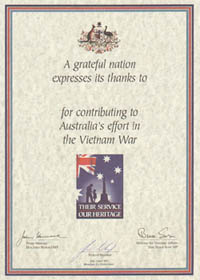
Certificate of Appreciation
Under the "Their Service, Our Heritage" scheme, the Federal Government, through local members has announced a "Certificate of Appreciation in Recognition of Service to Australia during the Vietnam War".
How are applications submitted?
Application forms are available from Federal MPs' offices, DVA Offices or can be downloaded from DVA Forms on the Department of Veterans' Affairs website: Application for Certificate of Appreciation - DVA Form: D0755
Applicants should complete the application form and submit this to their Federal Member.
Eligibility is decided by the Federal Member, in accordance with these guidelines.
Special Conditions
- Visits and Inspections, on duty, totalling 30 days count towards service for most stars and medals.
- Operational Service Terminated by death, wounds, or other disability due to service, qualifies as full service for most stars and medals.
It seems the powers that be updated all the Medals and Clasps application forms back in March 2013, and as a result the application forms for the following medals have been withdrawn in favour of just a general Application form.
Application for the Australian Defence Medal (ADM)
Anniversary of National Service 1951-1972 Medal (ANSM)
The NEW application forms are known as:
Issue of Medals
AD807 Application for the Issue of Medals and/or Clasps
AD809 Application for the Posthumous Issue of Medals and/or Clasps
Replacements (of Medals)
AD808 Application for the Issue of Replacement Medals and/or Clasps. (Original Applicant only)
AD809-1 Application for the Replacement of Posthumous Service Awards Due to National Disasters

